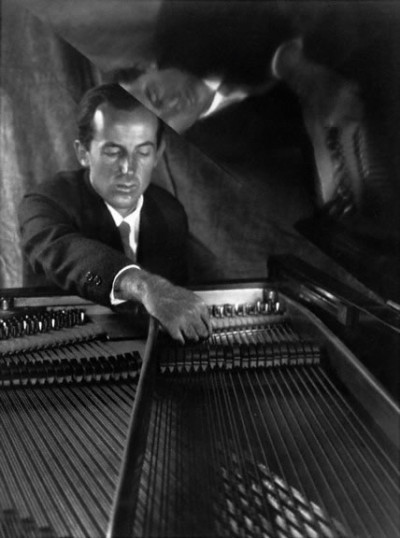Henry Cowell (Henry Cowell)

Born in rural Menlo Park, California, to two bohemian writers—his father was an Irish immigrant and his mother, a former schoolteacher, had relocated from Iowa—Cowell demonstrated precocious musical talent and began playing the violin at the age of five. After his parents’ divorce in 1903, he was raised by his mother, Clarissa Dixon, author of the early feminist novel Janet and Her Dear Phebe. His father, with whom he maintained contact, introduced him to the Irish music that would be a touchstone for Cowell throughout his career. While receiving no formal musical education (and little schooling of any kind beyond his mother’s home tutelage), he began to compose in his mid-teens.
By the summer of 1914, Cowell was writing truly individualistic works, including the insistently repetitive Anger Dance (originally Mad Dance). That fall, the largely self-taught Cowell was admitted to the University of California, Berkeley, as a protégé of Charles Seeger. There he studied harmony and other subjects under Seeger and Edward Griffith Stricklen and counterpoint under Wallace Arthur Sabin. After two years at Berkeley, Cowell pursued further studies in New York where he encountered Leo Ornstein, the radically “futurist” composer-pianist. Still a teenager, Cowell wrote the piano piece Dynamic Motion (1916), his first important work to explore the possibilities of the tone cluster (About this sound listen (help·info)). It requires the performer to use both forearms to play massive secundal chords and calls for keys to be held down without sounding to extend and intensify its dissonant cluster overtones.
Cowell soon returned to California, where he had become involved with a theosophical community, Halcyon, led by the Irish poet John Varian, who fueled Cowell’s interest in Irish folk culture and mythology. In 1917, Cowell wrote the music for Varian’s stage production The Building of Banba; the prelude he composed, The Tides of Manaunaun, with its rich, evocative clusters, would become Cowell’s most famous and widely performed work. In later years, Cowell would claim that the piece had been composed around 1912 (and Dynamic Motion in 1914), in an evident attempt to make his musical innovations appear even more precocious than they already were.
Cowell, who did not consider himself to be homosexual, was arrested and convicted in 1936 on a “morals” charge involving a 17-year old male. Sentenced to a decade-and-a-half incarceration, he would spend the next four years in San Quentin State Prison. There he taught fellow inmates, directed the prison band, and continued to write music at his customary prolific pace, producing around sixty compositions, including two major pieces for percussion ensemble: the Oriental-toned Pulse (1939) and the memorably sepulchral Return (1939). He also continued his experiments in aleatory music: for all three movements of the Amerind Suite (1939), he wrote five versions, each more difficult than the last. Interpreters of the piece are invited to simultaneously perform two or even three versions of the same movement on multiple pianos. In the Ritournelle (Larghetto and Trio) (1939) for the dance piece Marriage at the Eiffel Tower, performing in Seattle, he explored what he called “elastic” form. The twenty-four measures of the Larghetto and the eight of the Trio are each modular; though Cowell offers some suggestions, any hypothetically may be included or not and played once or repeatedly, allowing the piece to stretch or contract at the performers’ will—the practical goal being to give a choreographer freedom to adjust the length and character of a dance piece without the usual constraints imposed by a prewritten musical composition.
Cowell had contributed to the Eiffel Tower project at the behest of Cage, who was not alone in lending support to his friend and former teacher. Cowell’s cause had been taken up by composers and musicians around the country, although a few, including Ives, broke contact with him. Cowell was eventually paroled in 1940; he relocated to the East Coast and the following year married Sidney Hawkins Robertson (1903–1995, married name Sidney Robertson Cowell), a prominent folk-music scholar who had been instrumental in winning his freedom. Cowell was granted a pardon in 1942.
Born
- March, 11, 1897
- USA
- Menlo Park, California
Died
- December, 10, 1965
- USA
- Shady, New York


